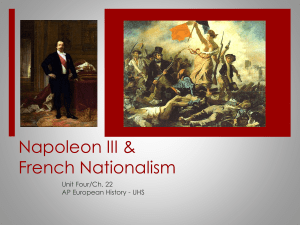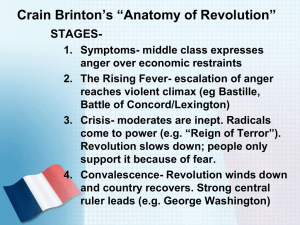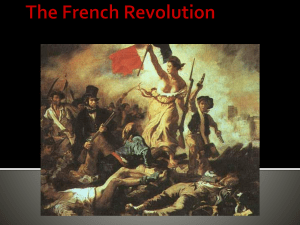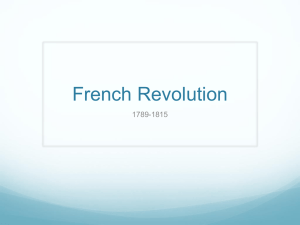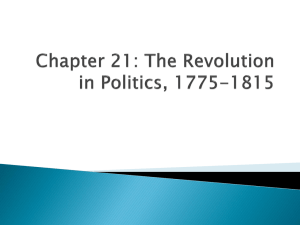The French Revolution and Napoleon
advertisement
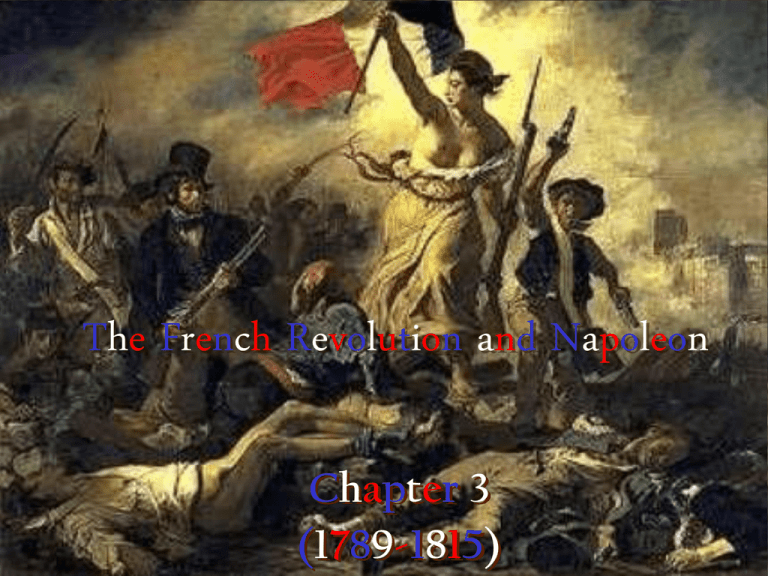
The French Revolution and Napoleon Chapter 3 (1789-1815) • Liberty Leading the People, a painting by Delacroix commemorating the July Revolution of 1830 but which has come to be generally accepted as symbolic of French popular uprisings against the monarchy in general and the French Revolution in particular. • In early summer of 1789, bread and other foods were scarce all over Paris. Talk of revolution filled the air. At Versailles, representatives of all classes had been meeting since May to find solutions to the economic problems that troubled France. But in Paris, many poor citizens focused their anger toward the government on the Bastille, where they believed hundreds of French citizens had been unjustly imprisoned. To the common people of Paris, the Bastille symbolized the tyranny of the Absolute Monarchy in France. • The Bastille was a huge prison fortress in Paris. Armed with axes, the crowd ran to the prison cells and freed the astonished inmates. The mob found only seven prisoners in the entire fortress. July 14, 1789 marks the date of the storming of the Bastille and the beginning of the French Revolution. • The Place de la Bastille is a square in Paris, where the Bastille prison stood until the ‘Storming of the Bastille' and its subsequent physical destruction between July 14, 1789 and July 14, 1790 during the French Revolution; no vestige of it remains. The Colonne de Juillet marks its place. The French Monarchy in Crisis • When the Sun King Louis XIV died in 1715, France was the richest, most powerful nation in Europe. It remained so throughout the 1700s. The French army was the most powerful in Europe, and its navy was rivalled only by that of Britain. French philosophers led the Enlightenment, and people across Europe followed French fashions in clothes, art, and even cooking. • At the same time, France suffered from a growing economic crisis. • Attempts to solve the economic problems of the country were hampered by the traditional political and social system of France, which historians call the Old Regime. Structure of the Old Regime • Under the Old Regime, the king was an absolute monarch. Louis XIV had centralized power in the royal bureaucracy, the government departments which administrated his policies. Louis’s successors lacked his abilities to govern. Nevertheless, they worked to preserve royal authority and maintained the rigid social structure of the Old Regime. • The people of France were divided by law into three estates: clergy, nobility, and commoners. The First and Second Estates • The First Estate included the higher clergy, who were nobles, as well as the parish priests. Some of the higher clergy lived in luxury at Versailles or in Paris. Parish priests usually lived a simple, hard-working life. • Many of them criticized social injustices in France and resented the privileges enjoyed by the higher clergy. The First Estate: Clergy • The clergy administered the church, ran schools, kept birth & death records, and cared for the poor. • To support these activities, the clergy collected the tithe – a tax on income. • The church owned vast amounts of land and other property on which it paid no taxes. The Second Estate: Nobles • The Second Estate, or nobility, made up less than 2 percent of the French population. • Many nobles enjoyed great wealth & privileges. Only nobles could become officers in the army or fill high offices of the church. • In addition, nobles were exempt from most taxes. The Third Estate: Commoners • The vast majority of French people were commoners belonging to the Third Estate. • The Third Estate included: the bourgeoisie, or middle class, peasants, and city workers. Third Estate: The Bourgeoisie • The bourgeoisie was small in numbers, but it was the wealthiest, most outspoken group within the Third Estate. • The bourgeoisie included successful merchants and manufacturers, educated lawyers and doctors, as well as small storekeepers and artisans. • They resented the privileges enjoyed by nobles. Many criticized the Old Regime because they believed in the Enlightenment ideas of equality and social justice. The bourgeoisie called for extensive reform of the tax system because the Third Estate carried the burden of paying most of the taxes. Third Estate: Peasants & City Workers • Peasants made up the largest group within the Third Estate. In general, French peasants were better off than peasants in other parts of Europe. • Another group within the Third Estate was city workers – servants, apprentices and day labourers. Like the bourgeoisie and peasants, city workers also resented the privileges enjoyed by the First and Second Estates. • This cartoon illustrates some of the burdens of the Third Estate. The clergyman and nobleman represent the First and Second Estates. They are riding on the back of an aged peasant, representing the Third Estate. The Growing Economic Crisis • During much of the 1700s, the French economy prospered. The population grew from about 18 million people in 1715 to about 25 million in 1789. Farmers produced food surpluses that fed the growing population and supported economic expansion. Mercantilist policies helped manufacturers in the textile and mining industries. • In the 1770s, however, economic activity slowed. Poor harvests hurt the economy. In addition, regulations surviving from the Middle Ages hampered any further expansion of trade and manufacturing. • The most serious economic problem facing the French government during the 1770s and 1780s was the huge debt it owed to bankers. The government had borrowed large amounts of money to pay for the wars of Louis XIV. Louis XV and Louis XVI continued to borrow money to support the court at Versailles and to fight wars to maintain French power in Europe and overseas. French support of the American Revolution alone nearly doubled the government’s debt. Who was…? • Robert Turgot (1727-1781) Section Review • Patterns of Civilization • Read p. 30 – 34 • P. 34 – #1 - 4 From Estates General to National Assembly • Each estate elected its own deputies to the Estates General. • When the Estates General met in May 1789, deputies from the Third Estate demanded that the three estates meet together, with each deputy having an equal vote. In the past, the three estates had met separately. Each estate voted as a group and had one vote. That way the First and Second Estates could outvote the Third Estate two to one. Deputies from the Third Estate hoped that if the estates met together and deputies voted individually, sympathizers among the clergy and nobles would give the Third Estate a majority. • When the king insisted that the estates meet separately, the Third Estate took matters into its own hands. On June 17, deputies from the Third Estate declared themselves the National Assembly and claimed the right to write a constitution for France. • Joined by many of the lower clergy and some reform-minded nobles, delegates of the Third Estate gathered at a nearby tennis court. There, they swore an oath, known as the Tennis Court Oath, promising not to disband until they had written a constitution. • Louis XVI hesitated, but then he ordered the other two estates to join the Third Estate in the National Assembly. • Although the three estates met as one body, there were deep divisions among the estates and within each one. Many clergy and nobles sought to protect their privileges. However, some nobles and lower clergy, along with many commoners, wanted to establish a limited, constitutional monarchy like the one in Britain. A few radical reformers demanded equality for all classes before the law. They wanted to abolish titles of nobility and all feudal obligations. They distrusted the king and opposed any constitution that would leave him with significant powers. Reforms of the National Assembly • The events in Paris and the countryside forced the National Assembly into action. During a long session on the night of August 4, many delegates rose to make impassioned speeches in support of reform. One noble urged that nobles be taxed. Another proposed that nobles give up their hunting rights. The clergy promised to end its tithes. • By the end of the evening, the Assembly had abolished most feudal customs. It ended serfdom and the tax exempt privileges of the nobles. What was…? • The Declaration of the Rights of Man • (August 26, 1789) The march on Versailles • In October 1789, a Paris crowd led by thousands of women marched in the rain to Versailles. The women were angry about high food prices. They also suspected that the king and the queen, Marie Antoinette, were plotting against the National Assembly. They demanded that Louis XVI and his family return with them to Paris, where they could watch over the king’s activities. To prevent violence, the king agreed. Marie Antoinette 1755 – 1793 • The king rode on horseback, escorted by a cheering crowd. He wore the tri-color, the red, white, and blue ribbon that the revolutionaries had adopted as their symbol. By forcing the king to wear the tricolor, the people proved that they were directing events in France. What was…? • The Constitution of 1791 Responses to the First Stage of the Revolution • Louis XVI grew increasingly alarmed at the actions of the National Assembly. He sought outside help, and Marie Antoinette appealed to her brother, the emperor of Austria, for support. In June 1791, the royal family decided to flee the country. When they fled toward the border, however, the king was recognized. The National Assembly sent officers to arrest the royal family and bring them back to the capital. • In October 1791, the Legislative Assembly, elected under the new constitution, met for the first time. The seating arrangements in the Assembly reflected divisions among the revolutionaries. Moderate revolutionaries sat on the right side of the meeting hall, and radical revolutionaries sat on the left side. • Moderates were embarrassed by the king’s attempted flight, but they wanted to preserve the constitutional monarchy. Radicals claimed that the king could not be trusted. They demanded the establishment of a republic. • However, the radicals themselves were further split. The most radical group, the Jacobins, demanded a true democracy in which all male citizens had the right to vote. As the French Revolution unfolded, the Jacobins and their leader, Maximilien Robespierre, would Maximilien Robespierre (1758-1794) gain the upper hand. Section Review • Patterns of Civilization • P. 38 – #1 - 5 France at War • France declared war on Austria in April 1792. At first, the war went badly for France. French armies were disorganized and poorly led. Many army officers, who were nobles, had left France. • By August 1792, Austrian and Prussian armies were advancing on Paris. The Prussian commander, the Duke of Brunswick, issued a declaration, known as the Brunswick Manifesto. He warned that if Paris did not surrender peacefully Austrian and Prussian troops would burn the city and put its leaders to the “tortures which they have deserved.” Duke of Brunswick (1735-1806) • Far from being frightened by the duke’s message, the people of Paris angrily declared that no foreign troops would crush the revolution. All over France, people rallied to defend the revolution and chanted the slogan: “Liberty, Equality, and Fraternity.” Soldiers from Marseille hurried to Paris singing a patriotic marching song, the “Marseillaise,” which was adopted as the National Anthem of France. • In September, the French defeated the Duke of Brunswick at Valmy. In the months that followed, revolutionary armies forced the invaders to retreat from France. • The war against Austria and Prussia caused high prices and desperate food shortages in France. Even while foreign troops threatened Paris, angry Parisians and sympathetic troops from the provinces joined in an uprising that has been called the second French Revolution. • Early in the morning of August 10, revolutionaries took over the Paris city government and established a new administration, the Commune. A large force of revolutionary troops marched on the Tuileries, where the king and his family lived. The troops attacked the palace, killing many of the king’s Swiss guards. • The king and queen fled to the Legislative Assembly, hoping for protection. But the radicals also seized control of the Assembly. They removed the king from office and voted to imprison the royal family. They then called for a national convention to write a new constitution. The National Convention • The National Convention voted to abolish the monarchy and make France a republic. The Convention then had to decide what to do with the king. The radical Jacobins demanded that Louis be tried for treason. • In November, the Convention discovered a trunk containing letters written by the king. The letters showed that Louis was plotting with foreign troops (émigrés) to crush the revolution. The damaging evidence sealed the king’s fate. The Convention tried and convicted Louis XVI of treason. • On January 21, 1793, Louis mounted the steps of the guillotine. “People, I die innocent!” were the king’s last words to the watching crowd. Section Review Patterns of Civilization P. 42 – #3 - 6 The Directory • The Constitution of 1795 established a new government known as the Directory. The Directory included an elected legislature and an executive branch with five directors. The Constitution restricted the right to vote to men who could read and who owned a certain amount of property. As a result, the middle class and wealthy landowners gained influence in the new government. “I am no ordinary man.” • Napoleon Bonaparte was trained to become an army officer at a French military academy. Napoleon rose quickly in the army during the revolution because so many officers fled France. • In 1793, Napoleon commanded the French troops that ousted the British from Toulon. By age 27, Napoleon was a general. • The young general soon received command of a French army for an invasion of Italy. He won several brilliant victories over the Austrians who ruled northern Italy. Napoleon’s successes forced Austria to withdraw from the war in 1797 and left Britain the only country still fighting France. • In 1798, Napoleon invaded Egypt because it was a vital lifeline to British outposts in India. Napoleon quickly defeated the Egyptian army. However, he suffered a disastrous setback at sea. The British fleet, under Admiral Horatio Nelson, destroyed the French fleet in the battle of the Nile. The loss of their fleet meant the French could not supply their troops in Egypt or take them home. Horatio Nelson (1758-1805) • Leaving the army in Egypt, Napoleon returned to Paris. The French people were not fully aware of the losses in Egypt, and they welcomed him as a hero. • In Paris, Napoleon found that many people were dissatisfied with the Directory. With the help of troops loyal to him, he and two directors overthrew the government in 1799. They drew up another constitution, the fourth since the revolution had begun. Under the new government, Napoleon was named First Consul. • At age 30, Napoleon was the virtual dictator of France. Napoleon’s Domestic Policy • In 1802, he had himself made First Consul for life. A plebiscite, or popular vote, overwhelmingly approved this move. Two years later, Napoleon Bonaparte proclaimed himself “Emperor of the French.” Once again, the majority of French voters endorsed his actions. • By 1804, Napoleon had gained almost absolute power. He knew the French would never stand for a return to the Old Regime. Therefore, he continued many reforms of the revolution. But at the same time, he kept firm personal control of the government. • In 1804, Napoleon became “Emperor of the French.” Pope Pius VIII officiated at the ceremony, which took place in the Cathedral of Notre Dame. As the pope prepared to crown the emperor, Napoleon took the crown and placed it on his head himself. By this gesture, Napoleon showed that he did not bow to any authority. The Napoleonic Code • Napoleon’s greatest achievement in government was the Napoleonic Code, which influenced French law to the present. • It recognized that all men were equal before the law and guaranteed freedom of religion as well as a person’s right to work in any occupation. • It put the interests of the state above those of individual citizens. In addition, it dropped laws passed during the revolution that had protected the rights of women and children. The Napoleonic code reflected ancient Roman law and made the man absolute head of the household with control over all family property. Other reforms • Napoleon enforced a law requiring all citizens to pay taxes. He also created the national Bank of France, in which the tax money was deposited. The Bank, in turn, issued paper money and made loans to businesses. • Napoleon also set up lycées (government-run schools). The lycées encouraged extreme patriotism, and the same courses were taught at each school. Usually, only the children of wealthy parents attended the lycées because of the tuition costs. However, some students received scholarships. Thus, the lycées represented a first step toward a system of public education – a lonstanding goal of Enlightenment thinkers and the French revolutionary leaders. Section Review • Patterns of Civilization • P. 45 – #1, 3 - 5 The Empire of Napoleon • In the early 1800s, France fought all the major European powers. • Through shrewd diplomacy, Napoleon usually kept the European powers divided so they could not unite against him. Europe under French rule • From 1807 to 1812, Napoleon was at the height of his power. He controlled an empire that stretched from France to the borders of Russia • While ruling this vast empire, Napoleon helped spread the ideas of the French Revolution across Europe. Throughout the empire, Napoleon introduced religious toleration, abolished serfdom, and reduced the power of the Catholic Church. He also made the Napoleonic Code the basis of law in many countries. • However, Napoleon lost much support when he imposed high taxes to finance his continuing conflict with Britain. The Continental System • Although Napoleon defeated the major powers on the continent, he was unable to bring Britain to its knees. • Admiral Nelson dashed Napoleon’s plans by sinking most of the French fleet at Cape Trafalgar, near Spain. Napoleon then decided to blockade British ports and thereby cut off its vital trade. • Under the blockade, which was called the Continantal System, Napoleon ordered all European nations to stop trade with Britain. Britain responded by declaring that any ship bound for France had to stop first at a British port and pay a tax. Napoleon countered with threat to seize any ship paying the British tax. • Unfortunately for France, the Continental System backfired. Britain did lose trade, but France suffered more. The powerful British navy was able to cut off overseas imports to France and the rest of the continent. This weakened the French economy. It also increased neutral nations who blamed him for their loss of trade. Stirrings of Nationalism • Opposition to Napoleon also grew among the conquered and allied peoples of Europe, who were developing a sense of nationalism, or pride and devotion to one’s own country. They resented paying taxes to France and sending soldiers to serve in Napoleon’s armies. They wanted to restore their own governments, customs, and traditions. As nationalists feelings grew, revolts broke out all over Europe. The Emperor’s Downfall • In 1812, Napoleon decided to invade Russia. Napoleon assembled an army of over 500,000 soldiers, and in May 1812, he led this Grand Army into Russia. • Napoleon planned to defeat the Russians in a quick, decisive battle. To his surprise, the Russians refused to stand and fight. Instead, they retreated, burning their crops and homes as they went. They forced Napoleon to lead his army deeper into Russia. The Russians finally engaged the French near Moscow, 500 miles inside Russia. The French won, but when Napoleon entered Moscow, he found the Russian capital in flames. Napoleon soon realized he could not feed and house his army in Moscow. Thus, in October 1812, he ordered a retreat. • During the retreat, the bitterly cold Russian winter turned the French victory into a disastrous defeat. Thousands of Napoleon’s soldiers starved or froze to death. The Russian army attacked the stragglers. Fewer than 100,000 escaped from Russia. • A powerful alliance made up of Britain, Austria, Russia, and Prussia pounced on the weakened French army as it limped out of Russia. Napoleon rushed home to raise a new army, but his efforts failed. In March 1814, the allies captured Paris. Napoleon abdicated and went into exile on the island of Elba, off the coast of Italy. • Although the monarchy was restored, the new king did not revive the Old Regime. In 1814, Louis XVIII issued a constitution that provided for equality under the law for all citizens, an elected legislature, and religious freedom. He also kept the Napoleonic Code. • When Louis XVIII became king, many émigrés returned to France and demanded revenge on supporters of the French Revolution. Napoleon took advantage of the resulting disturbances to return to Paris. In March 1815, he again proclaimed himself emperor. Discontented soldiers rallied to his side. For 100 days, he worked to rebuild the French army. But the European allies acted swiftly. Louis XVIII (1755-1824) • In June 1815, a joint British and Prussian army led by the Duke of Wellington defeated the French at Waterloo. Napoleon was exiled to the island of St. Helena in the Atlantic, where he died in 1821. Duke of Wellington (1769-1852) Napoleon at the Battle of Waterloo The Duke of Wellington at the Battle of Waterloo • In France, the revolution ended feudalism, with its special privileges for clergy and nobles. Although the monarchy was eventually restored in France, a written constitution limited the king’s authority. • Many theories have been presented as to why Napoleon is traditionally depicted with his hand in his waistcoat. Some of these theories include: that he had a stomach ulcer, he was winding his watch, he had an itchy skin disease, that in his era it was impolite to put your hands in your pockets, he had breast cancer, he had a deformed hand, he kept a perfumed sachet in his vest that he'd sniff, and that painters don't like to paint hands. • The true reason why Napoleon Bonaparte kept his hand in his vest and the answer is easy. It was fashionable at the time for gentlemen to stand in that way. Section Review • Patterns of Civilization • P. 48 – #3-6 • Recalling Facts


